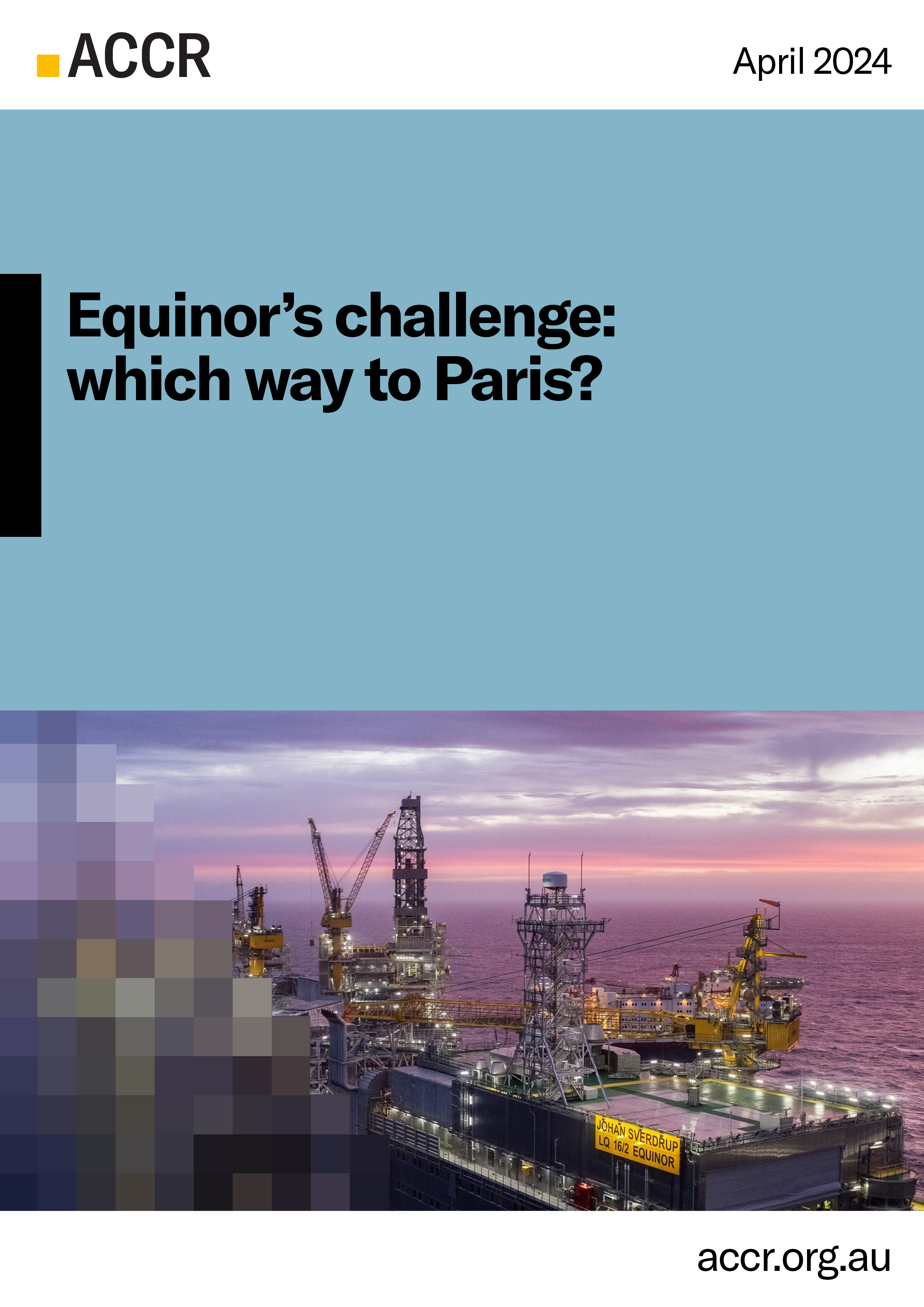Publication Equinor’s challenge: which way to Paris?
Executive Summary
Equinor ASA (“Equinor”) has an opportunity to take material steps towards Paris alignment by changing its portfolio and strategy.
While Equinor is taking commendable steps to transition its business, such as managing its Norwegian scope 1 emissions and being an early leader in offshore wind, Equinor’s Energy Transition Plan still falls short of the Paris Agreement’s goals, and investors are calling for more.
At the 2023 annual general meeting, the majority owner, the Norwegian government, laid down its clear expectations:
The company sets targets and implements measures to reduce greenhouse gas emissions in both the short and long term in line with the Paris Agreement.[1]
This report considers what Equinor can do to move closer towards Paris alignment without materially diluting shareholder value. It finds there are two crucial changes the company can make: stopping exploration of new oil and gas reserves worldwide, and halting development of pre-FID fossil fuel projects outside of the Norwegian Continental Shelf (NCS).
The International Energy Agency’s (IEA) only Paris-aligned scenario, the Net Zero Emissions by 2050 (NZE), has no need for new exploration or new conventional long-lead time projects, and highlights that some high-cost operating assets will not reach the end of their technical lives. To reduce emissions in line with the Paris Agreement would require Equinor to make broad changes to its fossil fuel strategy. This report, however, focuses on the two most commercially pragmatic steps that will move Equinor closer to Paris alignment.
We analysed Equinor’s exploration activities and found that, although exploration outcomes are uncertain, Equinor is unlikely to generate positive free cash flow from exploration until the 2050’s. Based on our global industry, least-cost evaluation of Equinor's alignment with the IEA's NZE pathway, we found that its major international unapproved oil and gas projects are neither Paris-aligned, nor relatively low-cost. Our review of Equinor’s international oil and gas investments to date found they have been capital intensive and are forecast to erode value.
Equinor’s unapproved international projects represent 67% of the emissions[2] from its total unapproved projects, making these recommendations a material step towards Paris alignment.
Key Findings
Equinor could take material steps towards Paris alignment by stopping exploration of new oil and gas reserves worldwide, and halting the development of pre-FID fossil fuel projects outside of the Norwegian Continental Shelf (NCS). Our analysis suggests this would not materially dilute shareholder value, and would avoid 67% of the potential emissions from Equinor’s total unapproved projects.
Equinor’s oil and gas exploration will inhibit a timely and orderly energy transition, by:
- directing Equinor’s resources away from the transition. Although exploration is inherently uncertain, Equinor’s exploration portfolio is not forecast to generate positive cash flow until after 2050. This is too late to start reinvesting cash flows to support the energy transition, and reduces access to capital to fund the transition over the coming decades
- producing a surplus beyond the requirements of a Paris-aligned world
- unnecessarily locking-in fossil fuel dependence beyond 2050. The majority of the future fossil fuel volumes from Equinor’s exploration portfolio are likely to remain unproduced in 2050
- going against the IEA’s statement to the oil and gas sector that “companies aligned with the results of the NZE scenario would not invest in new exploration”.[3]
None of the major unapproved oil and gas projects Equinor is seeking to develop outside of the NCS are Paris-aligned, nor are they relatively low-cost compared to all other unapproved oil and gas projects globally.
To date, Equinor’s international oil and gas production - in 16 countries outside of Norway - has not generated adequate value accretion for the company. Despite absorbing large amounts of capital, with $94 billion of capex (nominal, post-approval) on top of ~$14.5 billion in net acquisition and pre-FID costs (nominal), international projects are expected to deliver a negative net present value (NPV) return of -$3.6 billion.
Since Equinor's IPO in 2001, increasing international production has not been a key driver of Equinor’s total shareholder returns (TSR). In this period, the key driver of TSR was the oil price. This correlation is similar for peers in the industry.
Equinor's capital allocation strategy is optimistic, and highly sensitive to commodity price volatility. Around 60% of global oil unapproved supplies have a lower break-even price than Equinor's. The NPV of its unapproved, international projects would drop by 50% when assessed using the forward Brent curve, rather than Equinor’s optimistic oil price assumption of $75/bbl, indicating the company’s future projects may not be as valuable as they seem.
Recommendations
In terms of fossil fuel production, four key changes are suggested for Equinor to reduce emissions “in line with the Paris Agreement”. The first two are particularly commercially pragmatic recommendations and are the focus of the research in this report.
- Stopping exploration of new oil and gas reserves worldwide
- Halting development of pre-FID fossil fuel projects outside of the Norwegian Continental Shelf (NCS).
Becoming Paris-aligned would also require Equinor to:
- stop developing Norwegian fossil fuel projects. Equinor is a leader amongst oil and gas companies globally in minimising scope 1 emissions, particularly when operating within Norway. Nonetheless, none of Equinor's unapproved projects are consistent with the IEA’s NZE scenario.
- develop a strategy around winding down operating assets. The IEA’s NZE scenario sees much less oil and gas consumption than there are fossil fuel projects that are operating or committed. To meet the goals of the Paris Agreement, the oil and gas industry needs to consider how to wind down assets in a way that minimises costs, ensures energy security and provides a just transition.
View downloadable PDF of Equinor’s challenge: which way to Paris? | 04/2024
Please read the terms and conditions attached to the use of this site.
Equinor, Minutes of the 2023 Annual General Meeting of Equinor ASA, p2 https://cdn.equinor.com/files/h61q9gi9/global/8ec49409d8ac1bff4ba613604b3ffe36ee623d13.pdf?minutes-from-annual-general-meeting-in-equinor-asa-10-may-2023.pdf ↩︎
Equinor entitlement basis ↩︎
IEA, The Oil and Gas Industry in Net Zero Transitions, 2023, p149 https://www.iea.org/reports/the-oil-and-gas-industry-in-net-zero-transitions ↩︎
